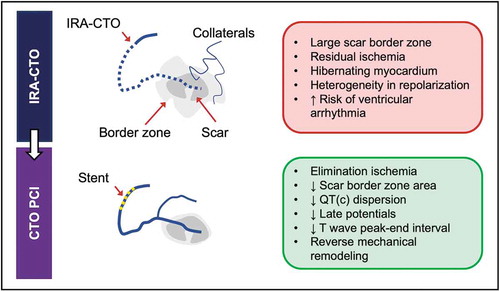Figures & data
Figure 1. Current recommendations for an ICD in patients with a CTO. Footnote. Based on the recommendations from the European Society of Cardiology (ESC), American College of Cardiology (ACC), American Heart Association (AHA) and Heart Rhythm Society (HRS) [Citation29–Citation31]. Abbreviations: EP, electrophysiology study; ICD, implantable cardioverter-defibrillator; LV, left ventricular; LVEF, left ventricular ejection fraction; MI, myocardial infarction; NSVT, nonsustained ventricular tachycardia; NYHA, New York Heart Association; SCA, sudden cardiac arrest; VF, ventricular fibrillation; VT, ventricular tachycardia.
![Figure 1. Current recommendations for an ICD in patients with a CTO. Footnote. Based on the recommendations from the European Society of Cardiology (ESC), American College of Cardiology (ACC), American Heart Association (AHA) and Heart Rhythm Society (HRS) [Citation29–Citation31]. Abbreviations: EP, electrophysiology study; ICD, implantable cardioverter-defibrillator; LV, left ventricular; LVEF, left ventricular ejection fraction; MI, myocardial infarction; NSVT, nonsustained ventricular tachycardia; NYHA, New York Heart Association; SCA, sudden cardiac arrest; VF, ventricular fibrillation; VT, ventricular tachycardia.](/cms/asset/a7fee5c4-6749-48b5-855c-c0fb7f20e3d5/ierk_a_1793671_f0001_oc.jpg)
Table 1. CTO and appropriate ICD therapy/mortality in ICD recipients with coronary artery disease.
Figure 2. Schematic overview of pro-arrhythmic effects of IRA-CTO and potential beneficial effects of CTO PCI.

